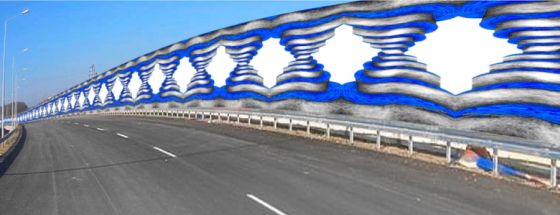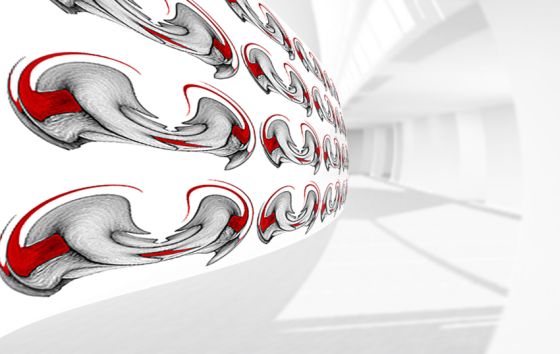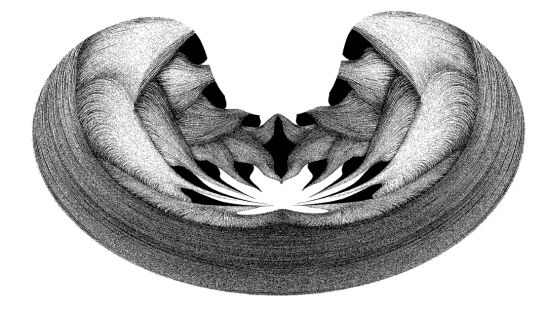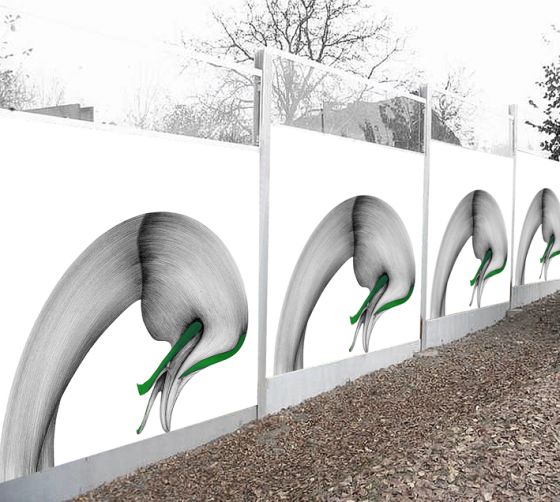Dariusz Bryl’s Organic Visions. Or, From Hand Drawing to Digital Rendering

Drawing
The artist in front of me. We've known each other for more than ten years. An open mind. Intellect in reticence. Balanced in his reactions. Focused. Now tense. Me too. We've made an appointment for a conversation. For the first time to deal with his art. He practices it in private. Professionally, he has successfully pursued the career of a graphic designer. He is appreciated for his skills, reliability, diligence. Let's also add a receptive and capacious memory.
I asked him to bring his portfolio. Letting me in on his well-guarded intimateness is obviously an effort for him. I knew fragments of the secret. They hardly arranged themselves into a cohesive whole. It is drawing. Of a peculiar, narrowly-packed score of the visual ‘keyboard'. A recurrent motif, like musical notation and the gesture of the drawing hand. One can get the impression it is a substitute of the word, speech, discourse. An integral part of the mental apparatus, the line of thinking. Manual energy powered, led and controlled by the central exchange, the brain. The latter working smoothly in keeping with the artist's intention (a presentation will take place in a moment), with the mechanical precision of a clock. Since Renaissance times, the line has enjoyed an autonomous position in hand drawing. It is on it, on the very thin line, that Dariusz Bryl's visual material came into existence, shaped itself and is being perfected.
It is at once his ‘copyright', his artistic contribution, his trademark, as well as a self-discovery, a discovery of his own Self. Someone who searches for and finds his identity. He wants to bring it to light. To look at himself. Starting with the inside, the blood circulation system, the senses. Outside, what each one of us physically possesses and perceives: skin, colours, light, sky, darkness, water, the infinity of space. Laughter and sound. Inexhaustible supplies of life. A field of investigations, inspirations, analogies, provocations, sometimes, or formal borrowings.
To understand Dariusz Bryl as a draughtsman, we decided to reconstruct on a sample the course, or trajectory, of a single line, their clusters and tangles.

Here is a description:
I'm drawing on my knees, resting on my elbows. Two sheets of paper glued together on the floor, together forming a 100x70 cm surface.
I move around this surface. Three pencils between the fingers of my right hand. One soft, two hard ones. Small enough to fit into my hand. It's easy to manipulate them depending on the quality, the thickness of the line. You need to handle these parameters: thinness, delicateness, direction. Starting point - here we go. The pencil ready for an oval, heading towards an arc as if on an open racing track. Another smooth transition to a convex arc, and from it, smoothly, invisibly, the pencil; the hand inclined, a concave stroke. And the other way round. From concave to convex. In one stroke. A biological, natural action of the tendon mechanism. A phenomenon noticed in the natural world. Subconsciously, I entered the world of the plants surrounding me. I was fascinated by how they looked, but was even more attracted to what was inside them. What is, actually, inside them? The construction, structure, the layers of a flower or grass stalk. I cut them to get there, to see, touch, become familiar. These fibres are nothing but the line strokes in my subsequent drawings. I watched leaves against the light. I remember various surfaces: coarse, spongy, glabrous, scurfy, porous...
Having evoked my youth for a moment, I continue drawing. I repeat the fluid and broad gestures. Stroke against stroke. Tangles, nodes. Then short, nervous. I change the direction of the hand's movement. Press the pencil more or less strongly against the paper without lifting it. The hand. A white sheet of paper underneath. It prevents me from rubbing and blurring the individual strokes. The sheet moves with the hand.
We still remain outside the form emerging. Now I try to get inside it. I did that in my youth in a naïve perception of the world, now consciously. What is it, how is it, the mysterious flesh that fills the outer shell of things? I believe it has colour, like physical phenomena. Accordingly, I make it particularly intense. Blue, red, purple - made with watercolour pencils. I've learned it has the properties I need. Applied in layers, it creates fluorescent colour. Produces the illusion of three-dimensional depth. The colour I've worked out of the inside of the object is an integral part of the complex construction. What I want is a visually active substance that irritates the eye. One could call it an optical provocation. The meeting of the inside substance and the outside shell takes place on the surface. They overlap: the colour and the greyness of the pencil lead.
The white of the surrounding surface is like oxygen, enabling my objects to breathe. It is a symbolic environment that doesn't disrupt their functioning in any way. It behaves like in laboratory conditions, almost sterile.
Digital Rendering
Our contemporary visual culture has changed irrevocably with the arrival of digital technology. The range of the tools the artist has at his or her disposal has increased greatly. Tools traditionally used by artists survived centuries in unchanged form. The artist using them found an outlet for his skills, his creative passion. It was his language, voice, his characteristic ‘self'. In the era of digital communication, tools became commonly available, evolving with technological progress.
The criteria of judgement have become blurry. It's hard today to distinguish between unique works and mass-produced ones. In certain areas, at least, the term ‘artist' has devaluated. One faces a dramatic choice: to yield to the pressure of the global ‘rush culture' or to retain your own style, to remain different. In the contemporary virtual world, the output product becomes unique. It acts as a generator. Producing energy, emitting a distinctness of vision. It also conceals mysteries others have no access to.
Hand drawing is like a matrix for me - a primordial form, the recording of an idea and its form, not a finite act, an act unto itself. The computer makes it possible to modify the shape of objects infinitely.
The original drawing becomes a digital image to be further processed. The computer is so precise a tool it makes it possible to achieve almost organic results in the optical sphere. In digital recording, the line is a compilation of sets of pixel-atoms.
I use a software program to ‘clean' the outlines of ‘noises' disrupting the substance of the hand drawing. Then follows the phase of manoeuvring in space. Detached from surface, form achieves a different, independent quality in a new shape. From now on, it is no longer to the law of gravity. I cannot help thinking of Malevich and his planits floating in cosmic space. A symbiosis occurs in this process. The interdependence of two entities: digital and manual. Let's imagine a space filled like a wallpaper, with a recurrent pattern, in architecture turned towards the ‘organic'.
Our conversation (there were several, in fact) about creative entities potentially present in digital images has come to an end.
Writing down these exchanges, I got the impression my interlocutor became split. On the one hand, he is aware of his achievements in the sphere of digital image, potentially subject to third-party replication. On the other hand, he wanted to confront a viewer. It was, I think, the aesthetical impulse working. To make your presence felt is a natural desire for any artist.
I want to share an experience from a few years ago. Without a word of warning, Darek pulled out from a portfolio several sheets of drawings. He presented them one after another, holding them in front of himself. Each featured a colourful icon, a shape, to which my senses reacted spontaneously. With a cry of delight! An unforgettable impulse of joy, like when suddenly meeting the light, something that is familiar and yet mysterious and strange. The author said nothing. His restraint surprised me. He made no slightest gesture that would signal he was pleased with the viewer's reaction. He didn't make it easier for me to learn the source of the strong, hard to control, emotional tension. I remained in that ignorance. He also demonstrated open reserve towards his friends' encouragements to pursue his artistic fascinations.
For me, a friendly observer, participant in many a graphic project, Dariusz Bryl remains a singular phenomenon in the field of recent Polish art. One of those who, relatively late, at the peak of their physical and mental powers, decide to reveal a new, different and, I believe, promising face. His drawing-and-colour ‘chords', transplanted from the digital world, could exist in the real. In a different environment. In the age of artificiality, craving for contact with nature intensifies. For centuries, and in many different ways, architecture has addressed the distinction between natural environment and the interior spaces we live in.

Filling Macro-Spaces with Patterns
The 21st century entered an era characterised by, among other things, an accelerated, virtually omnipresent spatial mobility. The rapid rhythm of contemporary life, whether conscious or not, is a result of various groundbreaking inventions and technologies. These epoch-making developments directly affect our daily life. However, besides their undisputed advantages, they also generate hazards in the psyche of individuals and communities.
We live under the constant pressure of the rush syndrome.
We speak and think in abbreviations, communicate in systems of signs. We perceive the world using ever more rapid means of transportation. Siegfried Giedion, the famous theoretician of material culture, correctly identified the era's defects in his 1941 book Space, Time and Architecture. He called it the ‘convulsions of the emergence of a new culture'. He also spoke of man's helplessness towards the growth of ‘mammoth cities', the ‘global village'. We, living in the 21st century, can mention some of the recent irritating anomalies that make themselves felt especially when we travel.
At some point, travelling inevitably becomes a monotonous experience these days. Space moves across landscape in a dull rhythm. There has been a tendency in urban planning to separate the traveller from whatever is characteristic about the places he passes. The individual, a curious creature by nature, becomes disorientated. He doesn't know where he is. Fortunately, he has the GPS to tell him.
The natural landscape is interrupted repeatedly. The ‘panel walls' of acoustic barriers stretching for miles without end. Anonymous details ruining psychic comfort, the phenomenon of transparency: the interpenetration of outer and inner space.
The project of Dariusz Bryl, graphic designer, draughtsman and sculptor, aims to visually fill great macro-spaces with digital patterns. Sequences of underground and overground patterns could contribute aesthetical values and an element able to offset the monotony of the otherwise anonymous spaces.
Conclusion from the Author of Dariusz Bryl's Organic Visions
I tried above to present and explain the ideas behind my project, descending gradually to the level of practical application. I realise it will encounter resistance, chiefly in terms of the mental inertia of the global society, living for 365 days a year in a kinetic frenzy1.
That the idea of ‘developing' space, that is, communication routes, is not solely mine is evidenced by the use of geometric forms alongside the Metz-Paris motorway.


- 1. We have talked so far about the travelling individual. This doesn't mean the project cannot be used to overcome the visual monotony of the world on the other side of the ‘panel wall'.


